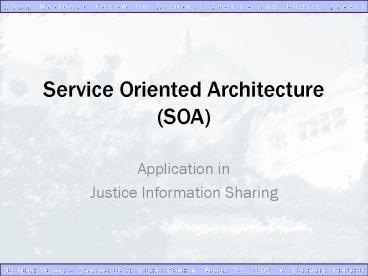Service Oriented Architecture SOA - PowerPoint PPT Presentation
1 / 20
Title:
Service Oriented Architecture SOA
Description:
... implementations, often with the aim to stress commonality. ... http://it.toolbox.com/blogs/the-soa-blog/soa-benefits-challenges-and-risk-m itigation-8075 ... – PowerPoint PPT presentation
Number of Views:382
Avg rating:3.0/5.0
Title: Service Oriented Architecture SOA
1
Service Oriented Architecture(SOA)
- Application in
- Justice Information Sharing
2
Enterprise Architecture Challenges
- How can I design a system which represents
effectively the business process and at the same
time is aligned with the key drivers of an
organization? - How can I build an architecture that could
respond to future changes without significant
modifications?
3
How Alignment and Agility are Achieved?
Business Process Layer
Services Interface Layer
Application Layer
.NET
J2EE
Legacy
4
Alignment Makes a Difference Today
- SOA is a bridge that creates a symbiotic and
synergistic relationship between the business and
the technology world. - This relationship is more effective, powerful and
valuable than anything experienced in the past. - The immediate result is achieving business
process quality with the help of technology.
5
Agility is the Promise of the Future
- The resulting architecture will evolve
effectively and efficiently as the underlying
business processes change. - Estimated reduction of information technology
expenses in the long term by as much as 20. - Savings become exponential over time as the
library of business services expand and greater
degree of reuse is achieved.
Based on Gartners estimate
6
Silos of Justice and Public Safety Information
- Existing systems are mostly custom built, use
custom means for integration, and exemplify
stand-alone silos of data which make it costly
for sharing information.
7
The Interoperability Challenge
- There are approximately 100,000 autonomous
agencies that have a critical need to share
information across their various information
systems. - This variety creates multiple layers of
interoperability problems because hardware,
software, networks, and business rules for data
exchange are different.
8
An Approach to Resolution
The existing systems store and interpret data in
a variety of different ways
The existing systems utilize different
technologies
Data Model
There are many existing ways to protect the data
and to manage users and their access
Many business processes span multiple agencies
and multiple systems
9
Available Global Solutions
The existing systems store and interpret data in
a variety of different ways
The existing systems utilize different
technologies
There are many existing ways to protect the data
and to manage users and their access
Many business processes span multiple agencies
and multiple systems
10
The Role of Architecture
- Minimize the dependencies between integrated
information systems. - Favor technologies that leverage open industry
standards. - Promote the treatment of integration interfaces
as sharable and reusable enterprise assets.
11
The Result is Effective and Efficient Information
Sharing
- This approach provides inherent agility and
scalability and can be utilized on multiple
levels for federal, state, local and tribal
sharing of justice and public safety information.
12
The Justice Reference Architecture (JRA)
- A Reference Architecture provides a proven
template solution and a common vocabulary with
which to discuss implementations, often with the
aim to stress commonality. - The Justice Reference Architecture is
- Developed specifically for the Justice domain and
focuses on information sharing in a complex
multi-jurisdictional environment. - Leverages the best practices of industry and
specifically the OASIS Reference Model for SOA. - Continuous effort to maintain consistency with
other architecture initiatives.
13
Mission, Vision and Audience
- Mission To enhance justice and public safety
through a service-oriented approach to
information sharing. - Vision Global JRA and related documents will be
the definitive source for justice and public
safety agencies providing guidance on
implementing a service-oriented approach to
information sharing. - Target Audience The target audience for the
reference architecture and guidance is any group
or set of justice partners that want to share
information and agree to implement common
business rules and infrastructure requirements.
14
(No Transcript)
15
Architecture Principles
- Independence of Information Sharing Partners
- Scalability to Allow Incremental Implementation
- Diversity of Data Source Architectures
- Long Term Agility
- Reuse and Sharing of Assets
- Alignment with Best Practices and Experience
16
The Two Main Use Cases
- Use Case One To provide a starting point for
local information sharing architectures - The architect of an information sharing
enterprise will use the JRA as a basis or
starting point for defining an information
architecture for that enterprise. The architect
may also use JRA services as a starting point for
describing the services to be offered within
his/her enterprise. - Use Case Two To provide a national architecture
for information sharing services - This objective expands the existing national data
model standards to provide a complete
architecture for standardized national
information sharing services. Part of this effort
is defining a standard set of commonly used and
mission critical services and their descriptions
17
Representative Projects
- Use Case One
- The Wyoming Criminal Justice Information System
(WyCJIS) - The Pennsylvania Justice Network (JNET)
- CONNECT
- Use Case Two
- Effort to perform business capabilities and
process analysis and to develop service
specifications for fusion centers
18
Summary of Benefits
- Alignment with Business Drivers
- Agility of the Information Sharing Environment
- Cost Efficiency as Services are Being Reused
- Reduced Risk Due to Incremental Implementation
- Federal Funding Opportunities Associated with
Conformance to Standards
19
Links to More Information
- The Global Justice Reference Architecture Site
- http//it.ojp.gov/topic.jsp?topic_id242
- The OASIS Reference Model for Service Oriented
Architecture - http//docs.oasis-open.org/soa-rm/v1.0/soa-rm.pdf
- The Service Oriented Architecture (SOA) Blog
- http//it.toolbox.com/blogs/the-soa-blog/soa-benef
its-challenges-and-risk-mitigation-8075 - Service Oriented Architecture, Thomas Erl
- http//www.thomaserl.com/
- Defining SOA as an Architectural Style
- http//www.ibm.com/developerworks/architecture/lib
rary/ar-soastyle/
20
Thank You!
- Iveta Topalova
- Analysts International
- 408-501-3705
- itopalova_at_analysts.com































